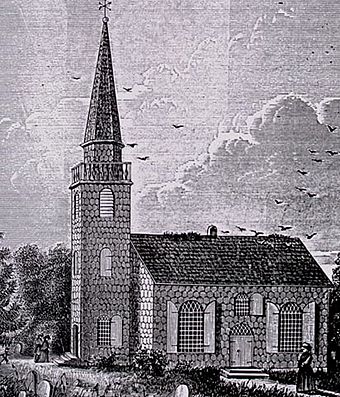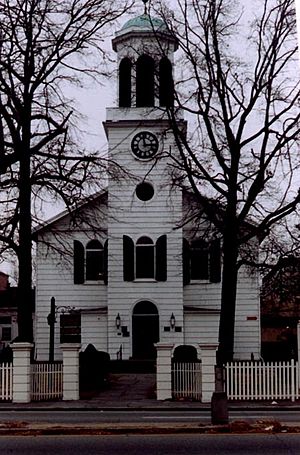St. George's Episcopal Church (Hempstead, New York) facts for kids
Quick facts for kids |
|
|
St. George's Church
|
|

St. George's Church circa 1734
|
|
| Location | 319 Front Street, Hempstead, New York |
|---|---|
| Built | 1822 |
| Architect | Timothy Clowes |
| NRHP reference No. | 73001211 |
|
Rectory of St. George's Episcopal Church
|
|

St. George's Rectory
|
|
| Location | 217 Peninsula Blvd., Hempstead, New York |
| Built | 1793 |
| Architect | Timothy Clowes |
| NRHP reference No. | 88000510 |
| Added to NRHP | May 3, 1988 |
| Added to NRHP | March 7, 1973 |
St. George's Episcopal Church is a very old church in Hempstead, New York. It is located at 319 Front Street. The church building you see today was built in 1822. Because of its history, it was added to the National Register of Historic Places in 1973.
The Rectory of St. George's Episcopal Church is a historic house nearby. A rectory is where the church's minister or priest lives. This rectory is at 217 Peninsula Boulevard in Hempstead. It was also added to the National Register of Historic Places in 1988.
Contents
Church History: A Look Back
St. George's Church was first started in 1702. The very first church building was replaced in 1734. However, that second building was later destroyed. The church building that stands today was built in 1822.
In 1735, the church received a special document called a charter. This charter was given by King George II of Great Britain. It officially recognized the church.
The Church During the American Revolution
During the American Revolution, Hempstead was a place with many British supporters. These supporters were called Loyalists or Tories. After the Battle of Long Island, the British army tried to take over Hempstead. They used St. George's Church as their headquarters. They also used it as a place to worship.
There's a local story about the rooster weather vane on top of the church steeple. People say it has sixteen bullet marks. These marks were supposedly made by Hessian soldiers. Hessians were German soldiers who fought for the British. They used the weather vane for target practice.
Later, American troops also used the church for a time. A commander named Ezekiel Cornell from Rhode Island was in charge. He used the church as a storage building. He also told the minister not to pray for the King. It is said that his soldiers even ate meals on the communion table.
Both the church and its rectory are important historical sites. They are listed on the National Register of Historic Places. This list includes places that are important to the history of the United States.
Building the Church in 1734
On April 2, 1734, a piece of land was set aside for a new church. This land was about half an acre. It was located west of the old church building.
At first, the new church only had some of its seats installed. There were eighteen pews, which were likely square-shaped. The very first pew was given to George Clarke. He was an important person who helped the church a lot. He lived in Hyde Park, which is now called New Hyde Park.
On November 1, 1734, the town held a meeting. Most people voted to move the seats from the old church into the new one.
Petitioning for the Church's Charter
On June 27, 1735, many people signed a petition. A petition is a formal request. They asked for a charter for the church. This charter would make the church officially recognized by the King.
Here are some of the people who signed the petition:
- The Rev. Robert Jenney, Rector.
- James Albertus
- Robert Marvin
- George Balden
- Jacamiah Mitchell
- Gerhardus Clowes, clerk of Vestry
- Joseph Mott
- Charles Peters
- William Cornell, Sr. & Jr.
- James Pine, Sr.
- John Cornell, Jr.
- John Roe
- John Cornell
- Micah Smith
- Richard Cornell, Jr.
- Peter Smith, Jr.
- William Cornell
- Timothy Smith
- Thomas Cornell, Jr.
- Peter Smith
- Isaac Germon
- Jacob Smith
- Thomas Gildersleeve
- Joseph Smith
- George Gildersleeve
- Silas Smith
- Daniel Hewlett
- Robert Sutton
- James Hugins
- Richard Thorne, Esq.
- Joseph Thorne, Esq.
- Joseph Langdon
- Thomas Williams
- William Langdon
- Thomas Lee
The Church's Consecration Ceremony
On Tuesday, April 22, 1735, a special event took place. The Governor of New York traveled to Hempstead. He went with his wife and family. They were there for the consecration of the church. Consecration means making something sacred or holy.
Many important people came with the Governor. These included his son-in-law, Secretary George Clarke, and the Chief Justice Delancey. Several ministers and many important merchants and ladies from New York City also joined.
About six miles before Jamaica, the Governor was met by horse troops. They escorted him to Jamaica for dinner. In the afternoon, he continued to Hempstead with the escort. He arrived in the evening and was hosted by Reverend Robert Jenney. Jenney was St. George's minister.
A Day of Celebration
The next day was St. George's Day. The local militia and troops lined up on both sides of the path. They stretched from Jenney's house to the church. The Governor walked to the church, joined by important local men.
Inside the church, Reverend Jenney gave a sermon. A sermon is a religious speech. The church was very crowded for this special occasion. Jenney spoke about verses 1 and 2 from Psalms 115.
After the service, the Governor inspected the militia and troops. They stood in formation. He was very pleased with how the officers and men looked. The Governor was then hosted by Colonel Tredwell, who led the regiment. Later that evening, he was hosted by Colonel Cornwell of Rockaway.
The New York Gazette newspaper wrote about the event. It said the Governor was happy with his welcome. He was also pleased by the large crowd and the militia's appearance.
Generous Gifts to the Church
Many generous gifts were given to the church on this day.
- The Governor gave the King's coat of arms. It was painted and gilded.
- Secretary George Clarke gave a beautiful crimson damask set. This fabric was for the communion table, pulpit, and desk.
- John Marsh gave a silver basin for baptisms.
- Reverend Vessey and his church members had already given about £50.
St. George's Church Today
The current church building has special features inside. Its oak columns were brought across the Hempstead Plains by horses. These columns were then shaped and put into the church's main area. They reach from the floor to the roof. They still look strong despite their age.
Some of the beautiful stained glass windows were designed by Tiffany Studios. Tiffany Studios was famous for its amazing glass art. The church also has padded pew boxes. These were special seats for wealthy families. In older times on Long Island, rich families would arrive at church in fancy carriages. They would then take their places in these front pew boxes.
See also
- Saint George: Devotions, traditions and prayers




